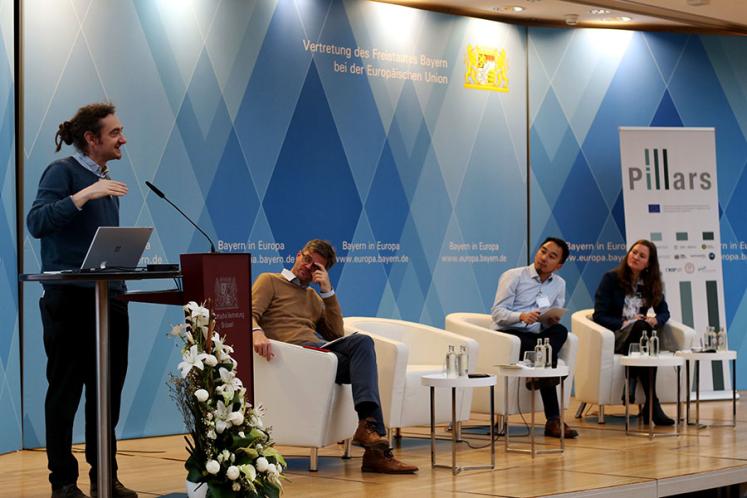UNU-MERIT‘s Tommaso Ciarli joins leading co-authors Ekaterina Prytkova, Fabien Petit, Deyu Li, and Sugat Chaturvedi in receiving the Best Paper Award at the 2025 CONCORDI Conference — one of Europe’s most influential platforms on innovation research and policy, jointly organised by the European Commission’s Joint Research Centre (JRC) and the OECD. The winning paper, “The Employment Impact of Emerging Digital Technologies,” explores how 40 emerging digital automation technologies reshape labour markets across Europe and offers new tools for understanding the future of work. The analysis resulted from the PILLARS Horizon project, led by ifo in collaboration with UNU-MERIT (University of Maastricht), SPRU (University of Sussex), Utrecht University, Catholic University of Eichstätt-Ingolstadt, CRISP – Interuniversity Research Centre on Public Services, Centre National de la Recherche Scientifique (CNRS), Technopolis, and Halle Institute for Economic Research (IWH) – Member of the Leibniz Association
We spoke with Tommaso about the paper’s motivation, findings, and next steps.
Interview
What was your research question?
Public and academic debates on digital automation technologies and employment tend to be polarised. Will emerging digital technologies such as AI, IoT, or 3D printing drastically reduce employment, or will they create new jobs? And for which workers? Most studies address these questions by focusing narrowly on a single technology—often industrial robots or AI—or by using highly aggregated measures that collapse many different innovations into a single “automation” index. Both approaches miss the critical reality that technologies differ in their function, and that they often complement each other, shaping labour markets unevenly across workers.
Our research was designed to overcome these limitations and address three core questions.
- First, how can we systematically measure the exposure of each industry and occupation to these different technologies?
- Second, what is the net employment impact of these emerging digital technologies on the European labour force?
- Finally, and most importantly, do all technologies affect labour markets in the same way? We hypothesised they do not—and that understanding this heterogeneity is essential for both academic theory and sound policy design. Our goal was to produce a granular, evidence-based map of the technological frontier of digital automation and its complex relationship with employment dynamics.
What did your paper find?
We uncovered three main findings.
First, we observe net employment gains across European regions between 2012 and 2019 in response to all digital technologies taken together. However, this aggregate result masks a more complex reality. We find job polarisation: employment increased for low- and high-skilled workers, but declined for middle-skilled workers whose routine tasks are more easily automated.
Our most important contribution comes from accounting for technological complementarities—the reality that technologies are often adopted together. By isolating the individual impact of each technology, we identify two distinct groups:
Labour-saving technologies—such as industrial automation, machine learning, and mobile payments—displace low- and middle-skilled workers by automating simpler tasks, while increasing demand for high-skilled workers who perform new and more complex tasks.
Labour-augmenting technologies—including 3D printing, remote monitoring, and e-learning—have the opposite effect. They increase employment for low- and middle-skilled workers by enhancing their productivity and enabling them to perform more complex tasks, while exerting downward pressure on high-skilled occupations.
What are the policy and academic implications of your findings?
- For academics, our work makes two contributions. First, we introduce a novel and scalable NLP-based framework for measuring technology exposure, which we are releasing as the open-access TechXposure database. Second, we show that analyses that ignore technological complementarities risk drawing misleading conclusions. A digital automation technology may show positive effects on employment when examined in isolation but have neutral or negative effects once interactions with other technologies are taken into account.
For policymakers, the implications are significant. The dominant narrative of “technology destroys jobs” misses the more important challenge: managing the distributional consequences of the profound technological changes we are witnessing. Policymaking must recognise that automation is not monolithic—even in the era of generative AI. Targeted incentives could encourage development and adoption of labour-augmenting technologies that increase opportunities for workers. Meanwhile, the clear displacement of middle-skilled workers calls for sustained investments in lifelong learning, retraining programmes, and adaptive social protection systems. Managing these transitions will be central to mitigating inequality as the technological frontier advances.
Will you apply, build on, or expand this research?
Absolutely. We see this paper as the starting point for a broader research programme.
A first priority is expanding and maintaining the TechXposure database, extending it to additional occupational classifications such as the US Standard Occupational Classification (SOC), and updating the list of emerging technologies including generative AI and green technologies.
Second, our current analysis focuses on Europe. A major next step is applying the framework to North America, emerging economies. The effects of digital technologies also propagate through global value chains, reshaping patterns of offshoring, reshoring, and employment distribution internationally.
Finally, while this paper captures the exposure of industries and occupations to digital technologies, we are also developing methods to study how such exposure is linked to actual adoption. This will allow us to examine how regions differ in technological uptake and how workers are affected by their adoption, providing more detailed guidance for policymakers seeking to manage the employment impacts of technological transitions.
Suggested citation: Ciarli Tommaso., " The Emerging Digital Technologies Reshaping Labour Markets: UNU-MERIT Paper Wins Best Paper Award at CONCORDi 2025 ," UNU-MERIT (blog), 2025-11-24, 2025, https://unu.edu/merit/blog-post/emerging-digital-technologies-reshaping-labour-markets-unu-merit-paper-wins-best.



